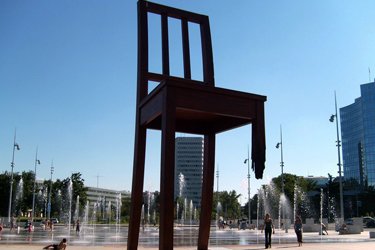
Geneva is known throughout the world with various names: for many it is “The city of peace“, for still others the “Protestant Rome” or “the smallest metropolis in the world“.
Geneva has a cultural offer envied by many large international cities, has a strong and rich economy, and is firmly in the top 3 of the most liveable cities in the world. Lying gently around Lake Geneva (which everyone calls Lake Geneva), it is a wonderful place to live, but also to spend a few days there.
The historic center, the tree-lined avenues, numerous gardens and parks, museums, theaters, make it an ideal tourist destination for a few days of relaxation and culture as you can discover by reading our tips on what to do and see in Geneva.
St. Peter’s Cathedral in Geneva
Perched atop a staircase on the highest point of the old town, St. Peter’s Cathedral has dominated Geneva since 1160. Today it is the most important Protestant church in the city, and also the seat of the assemblies of the Council of State, but its past is full of history. The austere and massive building has been remodeled several times and stands on the remains of pre-existing religious sites: the visit to the underground of San Pietro hides one of the largest archaeological heritages from the Roman era in Europe, with 3,000 square meters open to the public.

Until 1535, St. Peter’s Cathedral was the church of Geneva. The Protestant reform then stripped it of icons and treasures, in line with Calvinism which favors words over images. Today we can see the simple wooden chair from which Giovanni Calvino, one of the main exponents of the Reformation, read and commented on the Holy Scriptures for 23 years. To get an idea of the magnificence prior to the reform, enter the Maccabees Chapel, on the back: you will find yourself in front of an explosion of colors and lights. This chapel was built in 1405: returned to its splendor after the restoration of 1878.
Today it allows you to admire the copies of the frescoes (the originals are in the Museum of Art and History of Geneva) that covered it and the decorated windows that illuminate it from ‘tall.
The Cathedral of San Pietro also houses the largest collection of Romanesque and Gothic capitals in all of Switzerland.
To admire the panorama over the city, the lake and the Jura and Mont Blanc massifs, climb the 157 steps of the spiral staircase of the north tower of the cathedral: you will discover a unique and unforgettable view.
Palace of Nations
The Palace of Nations is the European headquarters of the UN and a complex of buildings, part of which is open to the public. It also hosts the UN Human Rights Council, the UN High Commissioner for Human Rights, the WHO and the International Labor Organization, among other things.
Guided tours allow you to learn about the history and activities of these international organizations, as well as discover unique environments such as the Assembly Hall, seat of agreements that have marked history, the Consultation Room, completely decorated with the murals of José Maria Sert, and the Hall of Lost Steps, from which you can admire the external park with the Celestial Sphere. It is a large bronze sphere that reproduces the 85 constellations, with 840 silver stars.

A short distance from the main entrance of the Palace of Nations is the Museum of the Red Cross and the Red Crescent, while in front of the main entrance of the building stands the Broken Chair (from the English “broken chair”). A 12-meter chair, with one of its four legs exploded in mid-air, the work of Daniel Berset commissioned by Handicap International.
A majestic and imposing warning addressed to countries that have not yet acceded to the 1997 Ottawa treaty against anti-personnel mines.
Patek Philippe Museum
Among the symbols of Switzerland, and of Geneva in particular, there are watches. The fame of Swiss watches was born right here in Geneva, at the end of the 1500s, when Calvinism banned the display of jewelry, forcing entire families of goldsmiths to specialize in more sober objects such as pocket watches, pendulum and then wrist watches. Today Geneva welcomes visitors with its Horloge Fleurie, a clock that tells the exact time thanks to a satellite and is made with colorful flowers and hedges. In Geneva you will find at least 50 single-brand stores of the most famous brands and a museum entirely dedicated to the art of watchmaking, the Patek Philippe Museum.

Here 500 years of clock history are documented, divided into two exhibitions. The Antique Collection, from 1500 to 1900, houses watches, musical automata and enamel portraits from all over Europe, while the Patek Philippe Collection exhibits the creations of this famous company since its foundation in 1839. Don’t miss the Caliber 89, the watch with the most complicated mechanism ever built.
The Old Town
The old town of Geneva can be appreciated on foot: perched on a natural hill on the left bank of Lake Geneva, it is a small, well-kept center, crossed by white avenues overlooked by antique shops, art galleries, wine bars and clubs, all perfectly harmonized in the architecture of the 1700s. The old town is dominated by the Cathedral of San Pietro but offers many other little gems, including the oldest house in Geneva, the Maison Travel, which is worth a visit because it is the seat of the Museum of Geneva Art and History.

The real center of the old city is the medieval Piazza Borg-de-Four, dominated by an 18th century fountain. To the southwest of the square is the Hotel de Ville: right here, on the ground floor, the Alabama Room hosted the Geneva Treaty in 1864, which gave the Red Cross the status of a humanitarian organization.
Lake Geneva and jet d’eau
The largest lake in Switzerland and Western Europe, Lake Geneva is the symbolic body of water of Geneva and is crossed by boats that connect France and Switzerland and are the ideal opportunity for suggestive cruises on its waters, and from the Mouettes, water taxis that allow you to move quickly from one side to the other.
At the point where the waters of the lake flow into those of the Rhone, one of the symbols of Geneva rises: it is the Jet d’eau, the highest fountain in Europe, whose jet rises 140 meters at a speed of 200 km times, with a flow rate of 500 liters of water per second.

The Jet d’eau is visible from all over the city and was created to relieve water pressure following the construction of a nearby hydroelectric plant; it has been moved several times and found its final location in 1891.
CERN
Among the thousand attractions of Geneva, CERN deserves special attention because it is the largest research institute of the European Organization for Nuclear Research in the world. CERN is located a few kilometers west of the center of Geneva, and since 1954, with the Geneva Treaty, it has allowed researchers from all over the world to study the fascinating universe of atomic particles.

CERN is open to visitors with two permanent exhibitions: “The Universe of Particles“, which explains and documents the world of particles, and “Microcosm“, an exhibition space of 500 square meters that traces the entire history of Research at CERN, including the “LHC, the Great Hadron Collider”. This collider is inserted in an underground tunnel that runs for 27 km between Switzerland and France, and is the most powerful and largest particle accelerator ever built. In 2012, the Higgs boson was detected right here.
Geneva Beach
Who said that Geneva is a city that is only visited for international congresses? It may be true, but the Genevans know how to relax. On the shores of Lake Geneva stands Geneve-Plage, an aquatic park that in over two hectares contains beaches, swimming pools, restaurant and bar, water games and wellness department and many sports activities, from windsurfing and canoeing on the lake to aquagym in pool. You will find an equipped beach, parks and gardens, an Olympic swimming pool, a children’s pool and even a 9 meter high waterslide. All in a unique setting, between the panorama of the lake and the green of the park. Geneve-Plage is a special opportunity to relax, have fun with the whole family and rediscover well-being.







